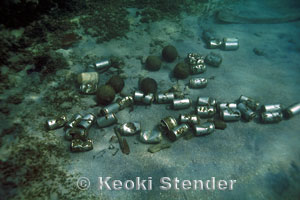 |
| 9:50 AM, 2 hrs past high-tide; drizzly |
 |
| 21+ feet of ancient tree brought in by a recent tide |
105 finds:
- Building materials: 16 (10 chunks of asphalt, fence slat, 3 wood offcuts, brick, tile)
- Foam/Styrofoam: 25 (all kinds)
- Fishing misc.: 17 (lobster trap bumper, shotgun shell wadding, 2 trap coatings, 2 trap scraps, 5 claw bands, 4 bits of rope, 2 bait bags)
- Food-related plastics: 6 (Capri Sun + straw wrapper, straw, Mondavi wine label scrap, "Simplify" Advanced H2O water bottle, Blue Diamond hickory-smoked almonds wrapper)
- Food-related metal/glass: 5 (can, scrap, glass mouth fragment, unID'd metal scrap, toothpaste tube)
- Non-food/unknown plastics: 26 (5 baggies/wrappers, 8 string/ribbon/tiestring, twisted coil, black tape, 5 scraps > 1", 6 scraps < 1")
- Cigarette filters/plastics: 8
- Paper/wood: 1 (note)
- Misc./unique: 1 (string)
 |
| Decaying aluminum toothpaste tube |
The bad news: Toothpaste tubes are one of the latest casualties of the "Make Everything Plastic" campaign. This aluminum tube is returning to the dust from which it came. 2011's varieties won't ever do that. As more of our world becomes plastic, more of it will persist when it gets lost to the environment. That's our future. Our present.
On to Zone S:
54 finds:
- Building materials: 17 (14 asphalt chunks, 2 brick, shingle)
- Foam/Styrofoam: 10 (inc. obvious bits from Zone N)
- Fishing misc.: 4 (2 trap bumpers, 2 trap coatings)
- Food-related plastics: 3 (straw, cup, cap seal)
- Food-related metal/glass: 3 (can scraps -- one freshly torn)
- Non-food/unknown plastics: 13 (2 bag scraps, 2 string bits, 1 tiedown, golf ball, pushpin head, melted cup, 1 scrap > 1", 4 scraps, < 1")
- Cigarette filters/plastics: 3
- Paper/wood: 0
- Misc./unique: 1 (cloth rope)
So after a few weeks of calm, the storm returns. 159 more pieces of manmade junk, from a quiet beach in Maine.
A parting photo for this week, from Zone N:
 |
| ! |
I will always wonder just what on earth this means.





